论文标题:(基于历史性城市景观与数字足迹视角的遗产廊道选线方法——以中国南京市历史城区为例)
期刊:
作者:xiang zhou, yuhang tang, junji su
发表时间:15 jun 2023
doi:
微信链接:


注:本文为删减版,不可直接引用。原中英文全文刊发于《景观设计学》(landscape architecture frontiers)2023年第3期“基于景观的遗产研究与实践”。
导 读
遗产廊道为公众提供了休闲娱乐、游憩健身等活动的连续线性空间。传统的遗产廊道选线研究大多聚焦于分析物质空间条件,忽略了公众感知表达和公共参与机制。基于历史性城市景观理念挖掘与传统遗产内容紧密关联的现代景观资源,本研究包括三个部分:1)通过数字足迹分析和最小累积阻力模型拟合物理语义选线结果;2)利用数字足迹构建共词矩阵,完成社会语义选线;3)耦合物理语义选线与社会语义选线结果,结合实际情况优化遗产廊道选线结果。研究实现了在遗产廊道选线过程中,将城市景观资源与公众游憩行为和空间感知的有效整合,有利于城市遗产的整体保护与公共空间的系统提升。
关键词
遗产廊道;选线;历史性城市景观;最小累积阻力模型;数字足迹;社会网络模型;城市景观资源
基于历史性城市景观与数字足迹视角的
遗产廊道选线方法
——以中国南京市历史城区为例
heritage corridor routing method from historic urban landscape and digital footprint perspectives
—the case of historical urban area in nanjing, china
1 东南大学建筑学院景观学系
2 东南大学建筑学院城市规划系
01
研究背景
“遗产廊道”研究强调通过河流、绿道、街道与铁路等线性空间要素,带动遗产保护与城市建设的协同发展。近年来,联合国教科文组织提议将历史性城市景观(historic urban landscape,hul)概念置于城市转型和全球化的背景中,研究不同历史时期形成的景观在城市空间发展中的作用与价值。hul倡议以一种基于景观的方法来识别、保护和管理历史地区,并在平衡城市建成环境与自然资源、当代需求与未来发展的基础上,将遗产保护和城市发展等目标及不同时空要素进行有效整合。
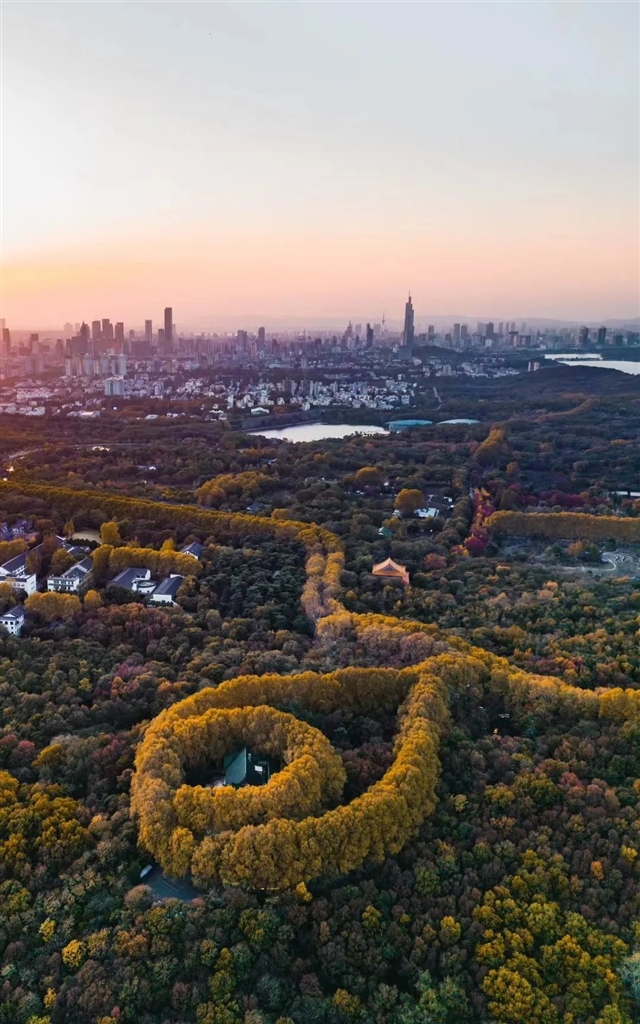
鸟瞰钟山之上的美龄宫 © 刘雅旭
从玄武湖上望向太阳宫与远山 © 谢伊鸣
传统的遗产廊道选线方法较少考虑游憩者自身的行为方式、感知体验、审美偏好等主观因素对选线过程的影响。进入数字化时代,公众留存在互联网的数字足迹可用于识别人群的行为规律与感知偏好。随着hul概念的提出,遗产廊道研究开始注重城市建成环境中历史文化与现代要素的融合,为了避免“遗产”概念的无限扩大,与传统遗产紧密关联的现代景观资源才是遗产廊道选线中需要考量的内容。
02
研究综述
在技术与方法层面,国外学者的研究以定性评价和理论分析为主,聚焦于对遗产廊道景观特征的分类评价,以及管理方法的优化提升等。国内学者对于遗产廊道构建方法的研究,主要是基于专家打分法分析城市环境,进而拟合生成遗产廊道线路。在上述研究中,mcr模型是当前遗产廊道选线的主流技术手段。而在选线内容上,目前的研究缺少对于游憩主体的行为与感知偏好的考量。
目前,社交媒体用户生成内容(ugc)已被广泛应用于遗产廊道研究领域。数字足迹主要包含两种类型:一种是由公众与通讯设施相互作用而产生的数据,如手机在使用过程中产生的位置日志和浏览记录等,;另一种是由公众上传到社交平台上的数据,如评价打分、旅行照片、行程记录等,其中,可从后者中探知公众在游览时真实的主观感受及游憩者与hul之间的互动关系。
03
研究技术路线
基础信息涵盖物理语义和社会语义两个方面。基于hul定义,仅将与传统遗产联系紧密的现代景观纳入遗产廊道景观资源选点。
物理语义选线研究分为关键连接点识别、适宜性评价与mcr模型模拟初步选线三部分。需求关键连接点表征公众对于遗产廊道的游憩需求程度;供给关键连接点揭示城市能够供给户外游憩活动的潜在空间。遗产廊道适应性评价方面包括城市综合环境评价和路径游憩潜力评价两方面,研究基于分析结果利用mcr模型拟合城市遗产廊道初步选线。
本文利用社会网络分析模型,将数字足迹活动节点中蕴含的游憩行为形成共词矩阵,然后透过游憩空间网络来研究游憩者行为特征与感知偏好的规律性。最后,通过计算游憩网络中各个节点的加权点度与中介中心度分级刻画景观资源点在公众感知层面上的空间分布特征。
研究将物理语义选线结果与社会语义选线结果进行叠合,并根据各景观资源点的中介中心度与加权点度等识别空间结构特征,对遗产廊道选线结果进行修正和优化。
04
实证研究
研究区域
本文以中国江苏省南京市历史城区为研究区域。南京历史城区主要由明城墙、护城河(湖)及周边缓冲地带环抱的空间组成,研究区域面积总计50.9km2。
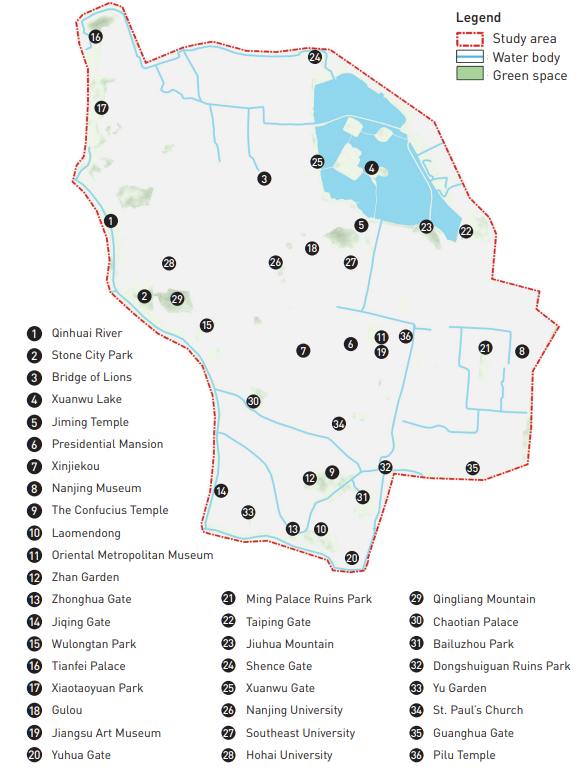
研究区域 © 周详,汤雨杭,苏俊吉
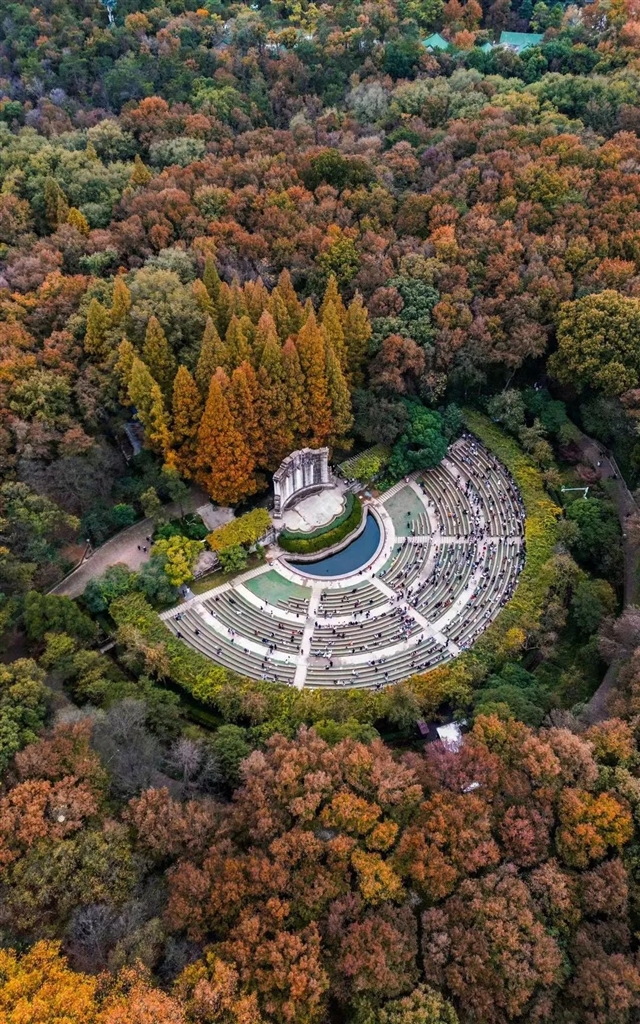
俯瞰中山陵音乐台 © 刘雅旭

远眺鸡鸣寺与玄武湖 © 刘雅旭
数据来源
本文将居住区poi数据、居民出行热力数据、城市夜间照明遥感影像像元亮度值(简称“夜间照明dn值”)作为需求端关键点识别的依据。将携程网、同程网、去哪儿网等平台中包含的传统遗产点及筛选出来的景观资源点,作为供给端关键点选取的主要依据。其中,根据景观资源点发布时的实时地理坐标,在地理信息系统(gis)中进行定位。
在城市综合环境评价方面,道路矢量数据通过openstreetmap获得;道路密度数据通过对道路矢量数据进行线密度分析获得;公共服务设施poi数据从百度地图api接口获得;地形、坡度数据从中国地理空间数据云平台获得;植被覆盖度数据通过珞珈一号卫星影像的ndvi数据获得。
在路径游憩潜力评价方面,人群高频活动路径通过出行热力数据与道路矢量数据叠加获得;河流缓冲区数据通过对获取自openstreetmap的城市水域矢量数据进行缓冲区计算得出;城市开放绿地类型数据同样来自openstreetmap。
数字足迹采集对象包括携程网的评论信息、同程网的游记信息,以及去哪儿网的行程记录,使用八爪鱼网络平台数据爬取器获取。本研究选取了140个景观资源点。对初始数据进行清洗、去重后,共采集到符合分析要求的评论信息4000条、游记信息904篇、行程记录1609篇。
基于城市物理空间因素的物理语义选线
该阶段主要包括关键连接点计算与适宜性评价两部分。其中,关键连接点分为需求端与供给端两类。首先,对居住区poi数据进行核密度分析,然后将其与居民出行热力数据和城市夜间照明dn值进行归一化处理并等权叠加。对叠加结果进行分类,并按照自然断点法依次划分为10个等级;分值越高,表示该区域中人群聚集程度与行为活力越高,出行需求也越高。本文将7分以上的区域作为人群活动扩散点源,共识别出需求端关键点40个。
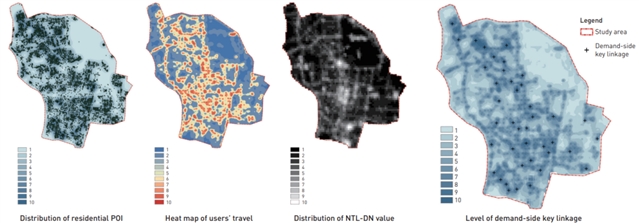
需求端关键连接点分析过程与结果 © 周详,汤雨杭,苏俊吉
供给端关键点包括遗产廊道的节点与终点,主要将景观资源点较为集中的区域作为游憩目的地供给来源。本文将筛选出的140个景观资源点在核密度分析的基础上进行归一化处理。将7分以上的区域作为人群活动吸引点源(即供给端关键点),共识别出供给端关键点30个。
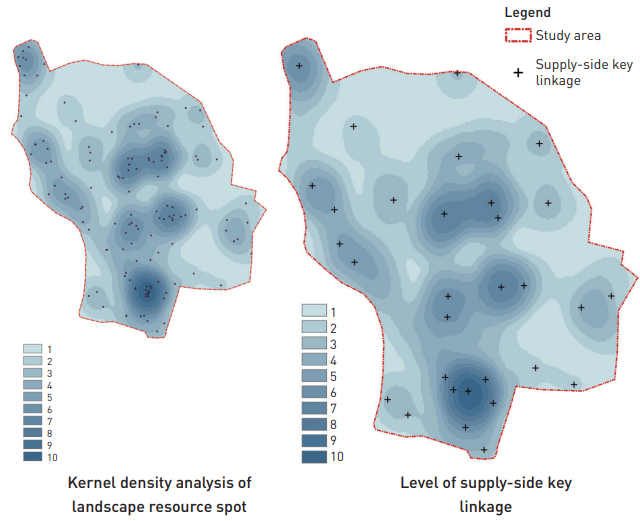
供给端关键连接点分析过程与结果 © 周详,汤雨杭,苏俊吉
阻力面分析可以模拟人群在通过城市空间时的难易程度,阻力值越高,表示人群空间流动越困难。本文主要通过城市综合环境评价与路径游憩潜力分析构建起一个包含5个评价方面、11项指标的阻力因子评价体系。最后,识别人群在空间流动过程中的最小成本路径,形成从需求端到供给端的适宜线路,由此完成基于城市物理空间因素的遗产廊道选线。
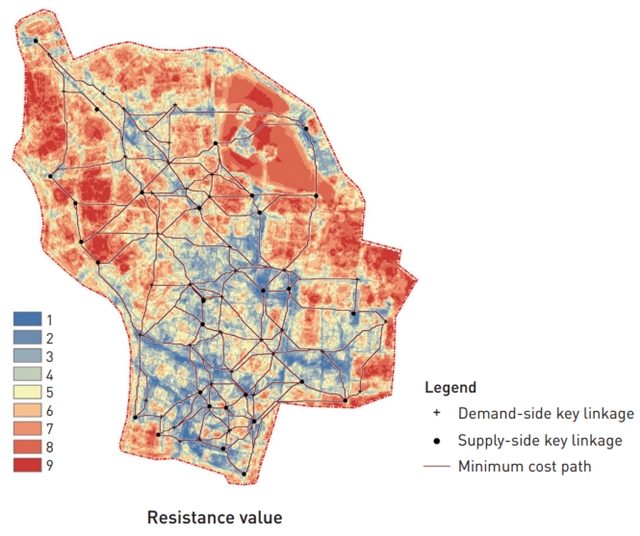
遗产廊道物理语义选线结果 © 周详,汤雨杭,苏俊吉
基于公众主观感受因素的社会语义选线
该阶段主要分为数字足迹分析与游憩空间网络特征分析两部分。首先,将上述筛选出的文本数据利用正则表达式构建数字足迹库。其次,识别公众的流量流向及行程偏好关系,生成反映人群空间移动整体偏好的共词矩阵。在gis中对上述矩阵关系形成空间格局,通过自然断点法,将流向强度由强至弱分为5级,对景观资源点之间的关联强度进行可视化,生成游憩空间网络。
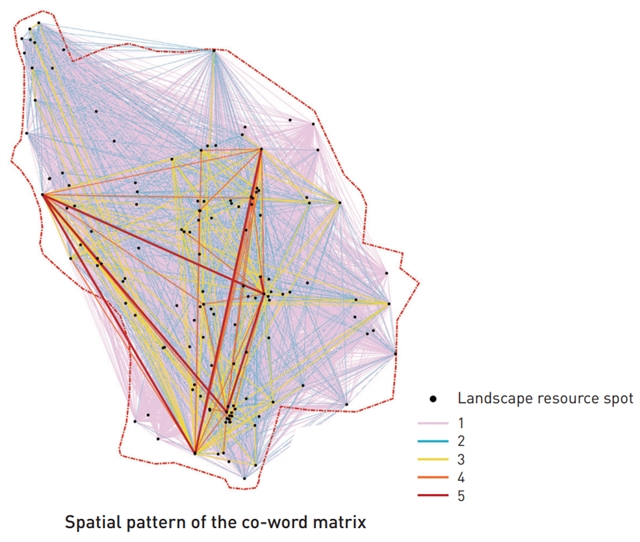
游憩空间网络 © 周详,汤雨杭,苏俊吉
研究进一步计算上述游憩空间网络中各景观资源点的加权点度和中介中心度,其中,加权点度数值越高,越适宜成为遗产廊道的重要节点;中介中心度数值越高,越适宜成为遗产廊道的中间节点。分别将上述两个指标划以自然断点法分为5级并叠加,完成基于公众主观感受因素的社会语义选线。
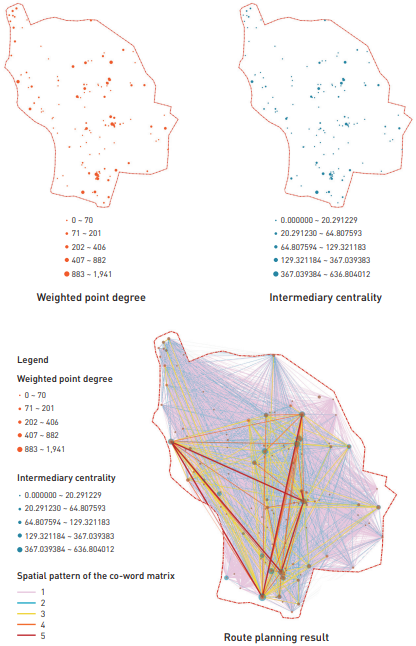
遗产廊道社会语义选线结果 © 周详,汤雨杭,苏俊吉
遗产廊道选线优化
鉴于城市发展建设更新与数据精度的影响,基于mcr模型的选线结果与实际道路有所偏差,需加以修正。研究发现,加权点度较高的景观资源点主要包括位于研究区域西部的秦淮河、石头城公园,位于北部的狮子桥、玄武湖、鸡鸣寺,中部的总统府、新街口,东侧的南京博物院,以及南部的夫子庙、老门东等。此外,由于研究区域内景观资源点较为密集,还存在着部分加权点度较高的节点中介中心度也较高的现象。而加权点度不高但中介中心度较高的景观资源点可以作为遗产廊道的过渡性节点。修正优化后的遗产廊道选线结果如图所示。
遗产廊道社会物理语义选线结果与社会语义选线结果叠合 © 周详,汤雨杭,苏俊吉
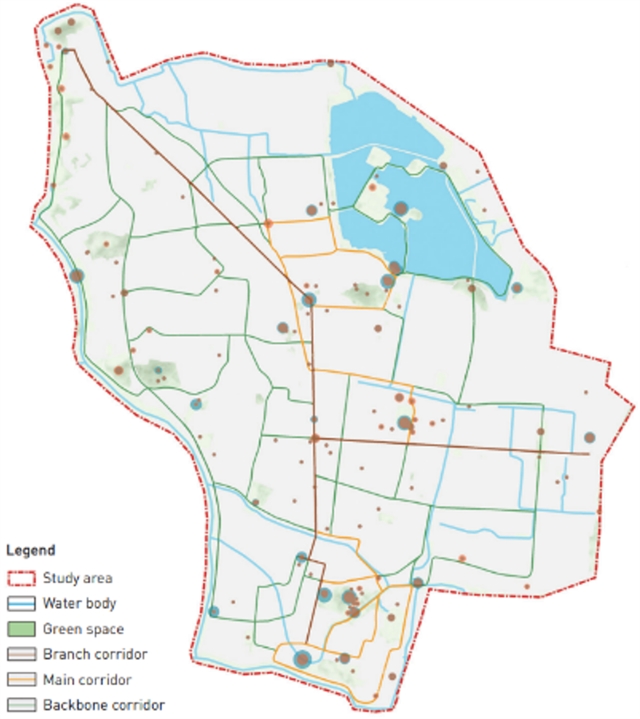
修正优化后的遗产廊道选线结果 © 周详,汤雨杭,苏俊吉

夫子庙游船码头夜景 © 汤雨杭
遗产廊道选线结果的应用价值
为了使遗产廊道选线结果对南京历史城区公共空间的品质提升起到更为直接的参考作用,本文将选线结果划分为骨干廊道、重要廊道与细化廊道三级。
骨干廊道能够对南京历史城区的整体结构起到风貌支撑作用;主要包括研究区域北部的天妃宫-鼓楼、中部的鼓楼-中华门,以及东部的新街口-南京博物院三条轴线,全长约11.5km。
重要廊道能够对南京历史城区范围内游憩流线的可达性与合理性起到重要的优化、调节作用;重要廊道主要呈组团分布,集中在研究区中部的狮子桥-鼓楼-江苏省美术馆区域,以及南部的中华门-雨花门-夫子庙区域,全长约18.4km。
细化廊道则能够对南京历史城区中公共空间体系的品质提升起到关键作用;细化廊道分布于研究区全域,全长约43.2km。
05
结论与讨论
本文构建的遗产廊道选线方法在传统物质空间分析的基础上融入了以数字足迹为代表的公众空间感知信息,使遗产廊道的关注点不再局限于城市物质环境,是融入公众感知表达机制的一次有益尝试。当前,将数字足迹转换为易于定量分析的结构化数据能以更加直观的形式实现,可有效解析游憩者与景观资源点之间的互动关系,从宏观层面理解人们的空间感知与游憩行为规律,也促进民众的行为偏好与感知也可以被应用于规划手段中。
本研究将具备主观情感的游憩者作为社会实体去分析,实现客观与主观、量化与质性的融合。然而数字足迹也面临着用户背景信息不完善、对平台技术设施依赖度高、数据公众开放程度差异性大等问题,因此目前仅能作为一种补充性的数据来辅助遗产廊道选线。同时,在景观资源点的筛选过程中,除了需要对数字足迹信息进行有效限定,仍需通过其他类型/来源的数据进一步限定选线对象,以提升选线结果的针对性与有效性。此外,如何提升数据精度、扩大数据代表程度、纳入更加多元的公众参与机制、完善主客观因素的耦合算法模型也是未来优化遗产廊道选线研究的重要方向。
参考文献
[1] flink, c. a., & searns, r. m. (1993). greenways: a guide to planning design and development (p. 167). island press.
[2] copping, s. e., huffman, p. b., laven, d. n., mitchell, n. j., & tuxill, j. l. (2006). connecting stories, landscapes, and people: exploring the delaware & lehigh national heritage corridor partnership (pp. 4–16). conservation study institute.
[3] gong, d., yuan, x., & zhang, q. (2016). the analysis of the operational mechanism of the american national heritage corridor and its enlightenment to the conservation and development of the large-scale linear cultural heritage in china. urban development studies, 23(1), 17–22.
[4] li, f., & song, j. (2010). corridor heritage: concept, theoretical origins and value appraisal. human geography, 25(2), 74–77, 104.
[5] zhou, j., jiang, d., bao, z., huang, y., yuan, y., & huang, d. (2021). historic landscape characterisation: linking “conservation areas” and “historic urban landscape”. urban planning international, 38(2), 1–18.
[6] li, x., & xia, h. (2023). evaluation of the regeneration value of a railway heritage corridor: a case study based on beijing-zhangjiakou railway (beijing section). south architecture, (3), 40–51.
[7] wang, y., gong, k., ji, j., lu, y., & zhong, g. (2022). progress and problems in the research and protection of heritage corridors in china. study on natural and cultural heritage, 7(5), 32–44.
[8] yu, k., li, w., li, d., li, c., huang, g., & liu, h. (2005). suitability analysis of heritage corridor in rapidly urbanizing region: a case study of taizhou city. geographical research, 24(1), 69–76.
[9] zhou, x., cheng, y., & kubota, a. (2020). globalization-based analysis of japanese community building movement from a micro-context perspective. landscape architecture frontiers, 8(5), 32–45.
[10] unesco world heritage centre. (2011). recommendation on the historic urban landscape [conference presentation] proceedings of the records of the general conference 36th session.
[11] zhou, x., & cheng, y. (2021). research on consumption space’s perception of the historic urban landscape based on the theory of scene. chinese landscape architecture, 37(3), 56–61.
[12] li, j., jing, f., & shao, y. (2022). global practices of the unesco historic urban landscape: ten-year review and insights for chinese urban heritage protection. city planning review, 46(11), 90–98.
[13] zhang, w., & han, f. (2017). a review of the theoretical and practical research on historic urban landscape. landscape architecture, (6), 22–28.
[14] jurkovi?, ?., hadzima-nyarko, m., & lovokovi?, d. (2021). railway corridors in croatian cities as factors of sustainable spatial and cultural development. sustainability, 13(12), 6928.
[15] byrne, d. (2023). the migration heritage corridor: transnationalism, modernity and race. international journal of heritage studies, 29(4), 329–345.
[16] zhang, d., wang, h., & cao, x. (2016). review of heritage corridor research in china. urban development studies, 23(5), 70–75.
[17] zhang, y., & ke, b. (2016). development report on heritage corridor in china. world regional studies, 25(1), 166–174.
[18] wang, y., zhang, x., & lu, m. (2010). study on planning of urban green space system based on construction of heritage corridor. chinese landscape architecture, 26(12), 85–87.
[19] salas-olmedo, m., moya-gómez, b., garcía-palomares, j. & gutiérrez, j. (2018). tourists’ digital footprint in cities: comparing big data sources. tourism management, (66), 13–25.
[20] zhou, x., sun, z., & liu, x. (2022). research on the spatial perception and recreational experience of historic urban landscape supported by the technology of digital footprint. new architecture, (1), 10–15.
[21] zhao, m., li, p., chen, c., & bian, z. (2022). continuous space production of living heritage sites based on tsl model: a case study of the old town of lijiang. tropical geography, 42(1), 67–77.
[22] li, h., & yang, h. (2018). the holistic protection strategy of urban historical and cultural landscape of xi’an premised on (hul) horizon. huazhong architecture, 36(7), 12–14.
[23] li, x., liu, x., cheng, k., & shi, c. (2022). research progress and visual analysis of heritage corridors in china. design community, (2), 143–151.
[24] wang, j., & li, f. (2016). a review of linear heritage literature at home and abroad. southeast culture, (1), 31–38.
[25] wang, z., & sun, p. (2001). heritage corridor: a comparatively newer protection and conservation method of heritages. chinese landscape architecture, (5), 85–88.
[26] xi, x., & chen, l. (2013). the preservation and sustainable utilization approach of the american erie canal heritage corridor and its inspirations. urban planning international, 28(4), 100–107.
[27] li, w., yu, k., & li, d. (2004). a theoretical framework for the heritage corridor and the overall conservation of the grand canal. urban problems, (1), 28–31, 54.
[28] lv, l., & huang, z. (2007). establishment and application of indexes of qualitative evaluation of tourism value for heritage corridor: a case study on the jiangsu section of the grand canal. china population, resources and environment, 17(6), 95–100.
[29] zhang, s., & zhen, x. (2017). from historical features preservation to urban landscape management: based on the historic urban landscape approach. landscape architecture, (6), 14–21.
[30] loren-méndez, m., mata-olmo, r., ruiz, r., & pinzón-ayala, d. (2016). an interdisciplinary methodology for the characterization and visualization of the heritage of roadway corridors. geographical review, 106(4), 489–515.
[31] boley, b., & gaither, c. (2016). exploring empowerment within the gullah geechee cultural heritage corridor: implications for heritage tourism development in the lowcountry. journal of heritage tourism, 11(2), 155–176.
[32] shigar, t., ginting, n., & suwantoro, h. (2018). how to improve the comfort of kesawan heritage corridor, medan city. iop conference series earth and environmental science, 126(1), 012204.
[33] hu, j., wang, y., & teng, y. (2020). xiaohe ancient road heritage corridor construction based on minimum cumulative resistance model. planners, 36(8), 66–70.
[34] wang, r. (2022). research on the construction of cultural heritage corridors in taiyuan city. modern horticulture, 45(19), 64–67.
[35] he, d., wu, z., & wu, h. (2022). construction of jingdezhen porcelain heritage corridor system based on mcr and mca models. geography and geo-information science, 38(3), 74–82.
[36] wang, k., liu, s., & shen, y. (2022). research hotspots and trends of heritage corridors in china. journal of green science and technology, 24(13), 140–145.
[37] zhang, d., he, y., xiao, q., jia, c., & wang, w. (2021). application of temporal and spatial behavior research in urban planning in china. in: urban planning society of china, chengdu municipal people’s government (eds.), spatial governance for high-quality development—proceedings of the 2020 china urban planning annual conference (04 history and theory of urban planning) (p. 7). china architecture and building press.
[38] zhou, x., liu, z., & shi, j. (2022). evaluation on visual landscape perception under the support of digital footprint: a case study of historic urban landscape of the qinhuai river area. landscape architecture, 29(9), 18–25.
[39] zhao, q., & liu, h. (2022). structure of night tourism flow network based on tourism digital footprint: a case study of chongqing city. areal research and development, 41(6), 105–110.
[40] wang, r., & wang, j. (2018). a research on attention and the co-occurrence effect of heritage corridor based on digital footprint: a case study of the silk road in china. tourism research, 10(6), 52–64.
[41] girardin, f. (2014). catching the world’s eyes. in: d. offenhuber, & c. ratti (eds.), decoding the city: urbanism in the age of big data. birkhauser verlag ag.
[42] girardin, f., balt, j., calabrese, f., dal fiore, f., & ratti, c. (2008). digital footprinting: uncovering tourists with user-generated content. ieee pervasive computing, 7(4), 36–43.
[43] girardin, f., vaccari, a., gerber, a., biderman, a., & ratti, c. (2009). quantifying urban attractiveness from the distribution and density of digital footprints. international journal of spatial data infrastructures research, (4), 175–200.
[44] wang, b., chen, x., & shi, c. (2021). analysis of recreational spatial features of wuhan city based on multi-source data. chinese landscape architecture, 37(6), 49–54.
[45] shi, y. (2020). the research on the method of route selection of urban greenway network under the guidance of ecology and recreation—taking lingshui li autonomous county of hainan province as a case [master’s thesis]. beijing forestry university.
[46] li, j., lei, y., & ren, l. (2022). exploration on the construction of cycling greenway network based on mcr model: a case study of central changping, beijing. green, smart, integrated—proceedings of the 2021/2022 china urban transportation planning annual conference (p. 10). china architecture and building press.
[47] zhang, l., & zhang, x. (2015). weighted clustering method based on improved critic method. statistics and decision, 442(22), 65–68.
本文引用格式 / please cite this article as
zhou, x., tang, y., & su, j. (2023). heritage corridor routing method from historic urban landscape and digital footprint perspectives—the case of historical urban area in nanjing, china. landscape architecture frontiers, 11(3), 11–37.

《前沿》系列英文学术期刊
由教育部主管、高等教育出版社主办的《前沿》(frontiers)系列英文学术期刊,于2006年正式创刊,以网络版和印刷版向全球发行。系列期刊包括基础科学、生命科学、工程技术和人文社会科学四个主题,是我国覆盖学科最广泛的英文学术期刊群,其中12种被sci收录,其他也被a&hci、ei、medline或相应学科国际权威检索系统收录,具有一定的国际学术影响力。系列期刊采用在线优先出版方式,保证文章以最快速度发表。
中国学术前沿期刊网

特别声明:本文转载仅仅是出于传播信息的需要,并不意味着代表本网站观点或证实其内容的真实性;如其他媒体、网站或个人从本网站转载使用,须保留本网站注明的“来源”,并自负yabo亚博88的版权等法律责任;作者如果不希望被转载或者联系转载稿费等事宜,请与我们接洽。